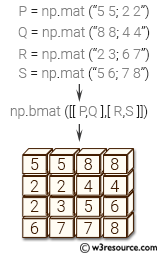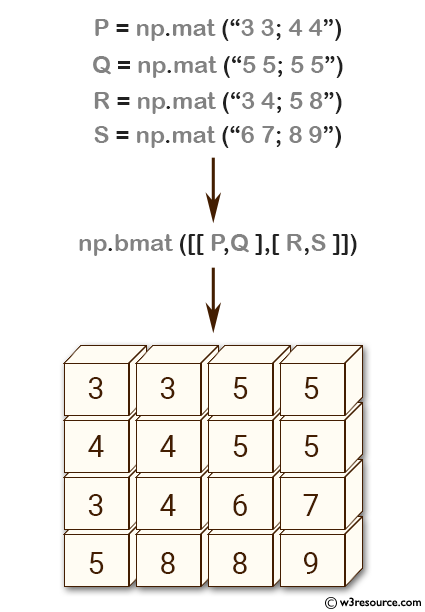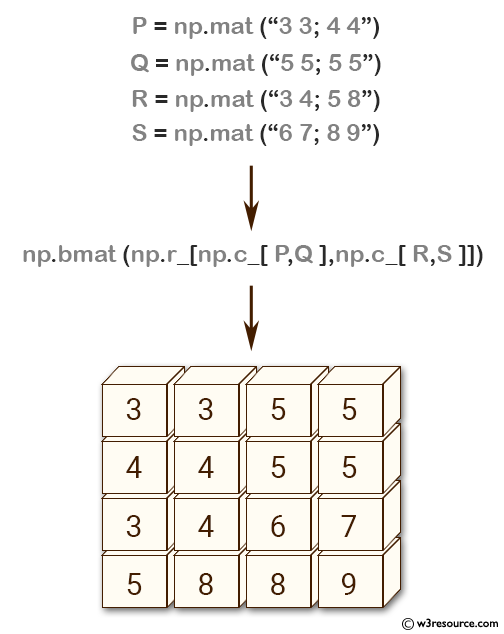NumPy: bmat() function
numpy.bmat() function
The numpy.bmat() function is used to built a matrix object from a string, nested sequence, or array.
Syntax:
numpy.bmat(obj, ldict=None, gdict=None)

Version: 1.15.0
| Name | Discription | Required / Optional |
|---|---|---|
| obj | Input data. If a string, variables in the current scope may be referenced by name. | Required |
| ldict | A dictionary that replaces local operands in current frame. Ignored if obj is not a string or gdict is None. | Optional |
| gdict | A dictionary that replaces global operands in current frame. Ignored if obj is not a string. | Optional |
Return value:
matrix - Returns a matrix object, which is a specialized 2-D array.
All the following expressions construct the same block matrix:
Example-1: NumPy.bmat() method
>>> import numpy as np
>>> P = np.mat('3 3; 4 4')
>>> Q = np.mat('5 5; 5 5')
>>> R = np.mat('3 4; 5 8')
>>> S = np.mat('6 7; 8 9')
>>> np.bmat([[P,Q], [R, S]])
matrix([[3, 3, 5, 5],
[4, 4, 5, 5],
[3, 4, 6, 7],
[5, 8, 8, 9]])
Pictorial Presentation:

Example-2: NumPy.bmat() method
>>> import numpy as np
>>> P = np.mat('3 3; 4 4')
>>> Q = np.mat('5 5; 5 5')
>>> R = np.mat('3 4; 5 8')
>>> S = np.mat('6 7; 8 9')
>>> np.bmat(np.r_[np.c_[P, Q], np.c_[R, S]])
matrix([[3, 3, 5, 5],
[4, 4, 5, 5],
[3, 4, 6, 7],
[5, 8, 8, 9]])
>>> np.bmat('P, Q; R, S')
matrix([[3, 3, 5, 5],
[4, 4, 5, 5],
[3, 4, 6, 7],
[5, 8, 8, 9]])
Pictorial Presentation:

Python - NumPy Code Editor:
Previous: mat()
Next: NumPy Array manipulation Home
- New Content published on w3resource:
- HTML-CSS Practical: Exercises, Practice, Solution
- Java Regular Expression: Exercises, Practice, Solution
- Scala Programming Exercises, Practice, Solution
- Python Itertools exercises
- Python Numpy exercises
- Python GeoPy Package exercises
- Python Pandas exercises
- Python nltk exercises
- Python BeautifulSoup exercises
- Form Template
- Composer - PHP Package Manager
- PHPUnit - PHP Testing
- Laravel - PHP Framework
- Angular - JavaScript Framework
- Vue - JavaScript Framework
- Jest - JavaScript Testing Framework
